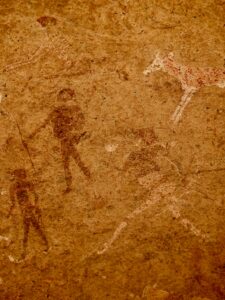
In this post, I shall be talking about
Social Media. When looking up ‘Social
Media’ on Google you will find many pages
telling you that ‘Social Media’ covers the
many different ways in which people use to
communicate with each other, and with the
online world.
I am going to look at some of the
different methods of social communication
we have used from early history to the
present day. We are all individuals who
are also social beings within our own
society; as such we all use Social Media
in a way to suit ourselves.
Five Forms Of Non-Digital Social Media
1 Cave paintings are probably one of the
earliest forms of people communicating
with each other. Often the cave art would
tell a story in picture form, possibly for
the rest of the clan to see and
understand.
2 Smoke signals were used by Native
Americans to pass on warning messages to
the rest of the tribe.
3 Beacons were used in a similar way to
smoke signals. Beacon fires with lit at
well-known locations on hills, seaside
cliffs, or other high places. One of their
uses was signalling that the enemy had
been sighted so that defences could be
prepared. Each beacon was part of a relay
system that was in sight of other beacons
placed at strategic intervals. When the
enemy was spotted the beacon would be lit
and those beacons in sight of it were also
lit. This meant that the information was
known by people who could act on it.
Beacons are also lit in happier times in
celebrations such as The Queen’s golden
and platinum jubilees.
4 Newspapers are possibly the best-known
non-digital media. Although we can also
get newspapers in digital form today.
People write to the Editor about many
different local problems; these letters
are then published in their own section
along with letters from other members of
the public.
5 Clubs, groups and societies are places
where like-minded people meet to socialise
and maybe have discussions about their
particular interests, for example, amateur
photography or politics.
Six Forms Of Digital Social Media
1 Facebook is a free social networking
platform. Once registered, users can use
it for many things, for example:
communicating with other users across the
world, game playing, and business use.
2 Twitter, members post short messages
known as ‘tweets’. Users can follow other
members’ tweets and can be followed in
return.
3 Linkedin is more of a site for business
people. Here they can make contact with
the business community and deal with those
they trust professionally.
4 Pinterest. The main focus of this site
is visual. Images are posted into
categories on the webpage together with a
brief description. When an image is
clicked on the user may be taken to
another site. For example, if the image
was a garden shed you might be taken to a
site that sells garden sheds, or the plans
to build one.
5 YouTube. Users share videos on this
site. It has gained a great deal of
popularity and many business people upload
videos showing their products being used.
6 Tik Tok is the new kid on the block. It
is also used to upload videos and is
gaining in popularity.
There are many other digital sites that I
could have listed, but for the sake of
brevity, I decided to stick with just six
of the well-known websites.
Conclusion
The coming of Digital Social Media has had
life-changing effects on us all. We can
socialize with people on a global basis;
we are no longer confined to one tribe,
village, town, city, or even one country
or continent.
We are the children of the digital age and
Social Media will continue to evolve and
grow into other ways of communication. The
way we use it, both personally and within
our businesses will certainly change as
it morphs into new and exciting online
technologies.


